Hanzell: Still Quality, Character and Reverence After 50 Years
“Into every bottle of wine made by a vintner of the old school went a little bit of himself.
Old time wine drinkers believed that the quality of a man’s wine depended on his own
quality and character. To gain lasting fame as a winegrower, a vintner had to be a poet,
a philosopher and an honorable man as well as a master craftsman.”
The quote above came to me in a packet recently from Hanzell and although there was no attribution, it was
clear that this was a reference to the long time Winemaker, now Winemaker Emeritus at Hanzell, Bob
Sessions. Sessions was born in Southern California and was first introduced to the world of fine wine while a
student studying English literature at University of California at Berkeley. A summer motor scooter trip with a
close friend through France opened his eyes to the profession of winemaking, fine wine, and fine dining.
Seven years after graduating from Cal, Sessions took a position as manager and winemaker at Mayacamas
Vineyards located at the top of Mount Veeder. It was during his time at Mayacamas that Sessions first met a
co-worker, Bradford (Brad) Webb, who became the founding winemaker at Hanzell Vineyards. Sessions is
credited with producing renown Cabernet Sauvignons at Mayacamas Vineyards from 1968 to 1971.
In early 1972, Sessions left Mayacamas Vineyards to become the production manager at Souverain Cellars in
Rutherford (now the site of Rutherford Hill Winery). It was at Souverain that he gained a preference for small,
family operated wineries. While assisting Warren Winiarski with the opening of Stag’s Leap Wine Cellars,
Sessions was approached by Brad Webb to interview for the position of winemaker and general manager of
Hanzell Vineyards. He welcomed the opportunity and assumed the role of Winemaker and General Manager
of Hanzell Vineyards in 1973.
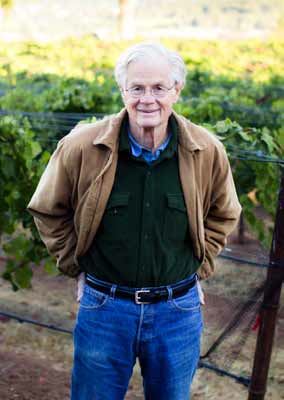
Sessions was the winemaker at Hanzell Vineyards for nearly 30 years. “Such long continuity is one of the
things that make us different from other wineries,” he says. “We inherited a standard of ingrained quality and
commitment to maintain not just the special taste and smell of the wines, but the breadth, depth and length of
the overall quality.” Current proprietor, Alexander de Brye, has worked closely with Sessions since acquiring
the winery in 1975 to maintain the standards that were established decades ago by the winery’s founder,
Ambassador Zellerbach. Zellerbach, who planted the first vines at Hanzell in 1953 (old Wente clone
Chardonnay and Martin Ray Pinot Noir), had the foresight to commit to Chardonnay and Pinot Noir at a time in
California when very few wineries were producing wines from these two varieties.
In 2002, Sessions retired and assumed the role of Winemaker Emeritus, passing on his knowledge and
experience to the winemakers that have followed, including current Winemaker Michael McNeill, only the fifth
winemaker in the estate’s history.
Sessions maintained the “Hanzell house style” developed by Brad Webb, and never succumbed to the oaky,
buttery style of California Chardonnay, or the highly extracted, ripe and fruit driven style of California Pinot Noir,
both of which became so popular over the last twenty years. The “Hanzell way” emphasis restraint, nuance,
food compatibility, and above all, age ability. The wines speak of the unique terroir of the Hanzell hillside
estate, blessed with a concentration of Red Hill volcanic soil rarely founded in Sonoma County, and cooling
maritime winds from the Petaluma gap. At Hanzell Vineyards, the emphasis is on the vineyard and not the
winemaker who is but a shepherd of the Hanzell tradition. The current winemaker, Michael McNeill, told me, “I
don’t want my fingerprints on the wines.”
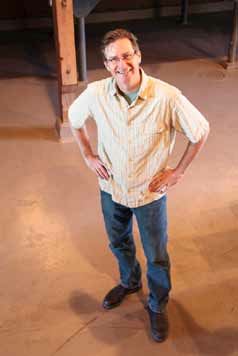
Sessions had a steadfast commitment to St. George rootstock and this has kept the estate safe from
phylloxera. His belief in rigorous pruning vine by vine kept the quality of fruit at a high level on the estate. His
ability to create wines that could be cellared for decades is rare. The most notable milestones for Bob
Sessions are listed below.
1973: He becomes only the third winemaker in Hanzell Vineyards’ history.
1976: Sessions plants five acres of the de Brye Vineyard to Cabernet Sauvignon, Merlot, Cabernet Franc,
Petite Verdot and Malbec. The remaining eight acres are planted to Old Wente Chardonnay clone on St.
George rootstock and Mt. Eden clone Pinot Noir on St. George rootstock.
1983: He installs drip irrigation in every vineyard, recognizing that drought was inevitable. Visionary in his field,
the drip system did not need to be used until 1996.
1974: Sessions begins experimenting with whole cluster fermentations for Pinot Noir. Abandoned for a time in
the 1990s, McNeill has recently put it back in use after reflecting on the age ability of the older Pinot Noirs.
1993: Sessions grafts over the five acres of Bordeaux varieties in the de Brye Vineyard to Chardonnay and
Pinot Noir.
1997: An additional eleven acres of vineyard was chosen, designed and installed by 2002 on the 200-acre
estate.
1999: Sessions research led him to design a special 4.5-acre plot on the estate with eleven different rootstocks
and clone combinations of Pinot Noir. Proprietor Alexander de Brye named the newly planted Pinot Noir block
in Sessions’ honor.
2002: Sessions is named Winemaker Emeritus in January. A new winery development breaks ground.
Sessions and Hanzell President Jean Arnold are married on October 19.
2004: Completed winery has eighteen custom made one-ton fermentation tanks and 500 linear feet of cave.
The new “tankitos” replicate the quality and style of the original 1950s tanks designed by Ambassador
Zellerbach.
2005: After 28 years, Sessions hands off his winemaking duties to Michael Terrien.
2008: Sessions oversees the planting of five acres of Chardonnay in the Zellerbach Vineyard that is named in
honor of the original founder. McNeill joins the winery as winemaker.
2013: 2010 Hanzell Pinot Noir, Sessions Vineyard is released, celebrating Sessions’ 40th year with the estate,
the first in a series of estate vineyard selections.
The 200-acre Hanzell Vineyards property in Sonoma Valley includes 46 planted acres divided into six
vineyards, and is home to the Ambassador’s 1953 Vineyard, the oldest continuously producing Chardonnay
and Pinot Noir vines in North America (pictured below overlooking the town of Sonoma).
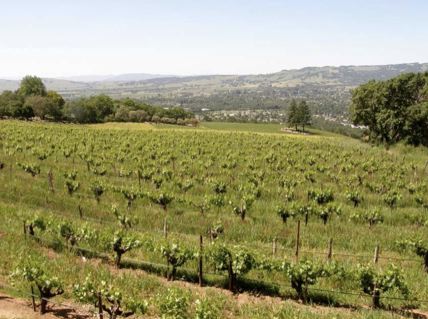
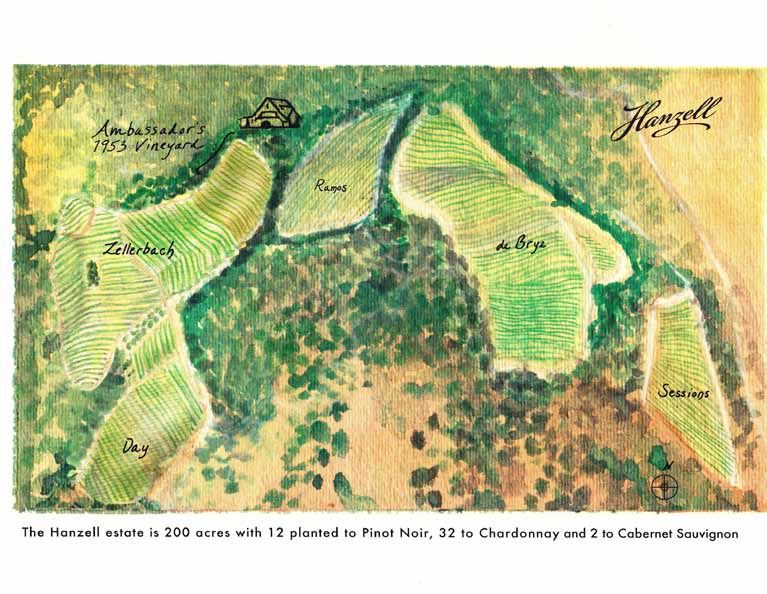
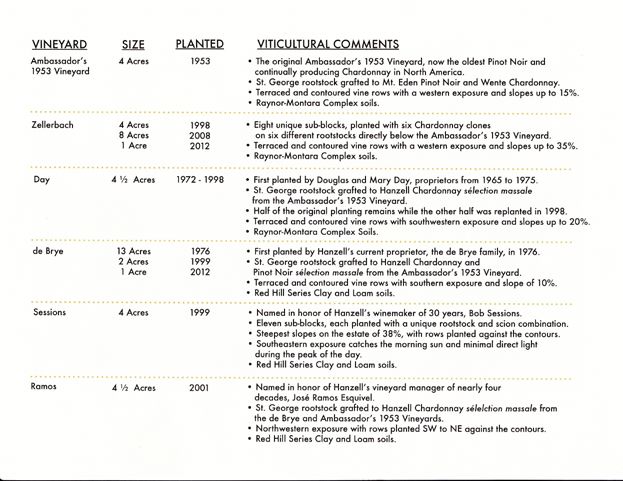
Hanzell Vineyards producing 6,000 cases annually, three-quarters of which is Chardonnay and one-quarter of
which is Pinot Noir. All wines have been estate grown and produced since 1960. As dictated by tradition and
the house style, the Hanzell wines have always been aged in Sirugue barrels, 50% new in the case of Pinot
Noir and about 33% new for Chardonnay. The Sirugue barrels produced pure fruit expressions with smoky
vanillin and fresh-baked bread aromas, and highlight tropical and lemon components. For Pinot Noir, the
Sirugue barrels add finesse and subtle aromatics of exotic spices and roasted herbs. Beginning with the 2011
vintage, Hanzell is now working with seven different cooperages but is not planning to chance the overall style
of the oak program.
Hanzell Vineyards Chardonnay winemaking goes on as follows. The grapes are hand harvested in the cool of
the morning. They are promptly brought to the winery and sorted again. Tradition dictates limited skin contact,
carefully controlled inoculated fermentations, and a moderate use of new French oak. The 2010 estate
Chardonnay was 30% barrel fermented, spending 12 months in 30% new French oak barrels and 6 months in
bottle before release. Hanzell Vineyards “Sebella” Chardonnay is 100% stainless steel fermented and finished
and aged 6 months in one to four-year-old French oak barrels.
Hanzell Vineyards Pinot Noir winemaking goes on as follows. The grapes are 100% de-stemmed, cold soaked
for 5 to 7 days in one-ton fermenters, inoculated to start fermentation, punched down by hand, and kept in
contact with the skins for two weeks following fermentation. Clone and rootstock combinations as well as
vineyard blocks are vinified separately until blending decisions are made shortly before bottling. Total élévage
in the 2010 vintage was 18 months in 50% new French oak barrels.
The 2010 Hanzell Sessions Vineyard Pinot Noir was introduced in March 2013, celebrating Winemaker
Emeritus Bob Sessions. Only 99 cases of this new single vineyard selection were produced. President Jean
Arnold Sessions remarked, “Proprietor Alexander de Brye felt the last block of Pinot Noir planted at the estate
should bear Bob’s name and we are thrilled to mark Bob’s 40th year with the winery with this special release.”
The four and one half-acre Sessions Vineyard, planted in 1999, is considered the pinnacle and most difficult of
vineyard plantings that Sessions created in his career. The numerous rocks, the drainage and the extreme
slope were all tremendous challenges in planting this vineyard. Composed of Red Hill Series clay and loam
soils, the vineyard rows are planted vertically against the contours of the 38-degree slope. Eleven sub-blocks
feature unique Pinot Noir rootstock and scion combinations (seven clones and four different rootstocks) and the
southeastern exposure catches the morning sunlight yet shields the vines from direct light during the peak of
the day.
Sessions Vineyard photos follow (top to bottom: view of Sessions Vineyard from the top, Sessions Vineyard
Pinot Noir, and Sessions Vineyard Cluster).
Hanzell wines are available for purchase by guests visiting the new Hanzell Vineyard’s website at
www.hanzell.com. The website includes one of the most in-depth tasting note archives of Hanzell wines
publicly available, allowing a search of vintages dating back to 1967. The Collector Program guarantees an
allocation of Hanzell Vineyards Pinot Noir and Chardonnay and Ambassador’s Circle Exclusive and Private
Collector levels provide access to the Ambassador’s 1953 Vineyard releases, the Hanzell wine library annual
offering and the holiday magnum offering. Two additional Estate Single Vineyard wines will be released this fall:
2011 Hanzell Chardonnay, de Brye Vineyard, and 2011 Hanzell Chardonnay, Ambassador’s 1953 Vineyard. In
2014, single vineyard wines from Ramos Vineyard and Day Vineyard will be introduced.
Visitors are received by appointment only (707-996-3860 or email maildesk@hanzell.com). Two levels of visits
are offered, both of which include a guided vineyard tour and seated tastings.
Decanting Hanzell wines is highly recommended. Stand the wines upright for some time before opening to
allow any possible sediment to settle. At the winery, the wines are always decanted a minimum of one to two
hours before service. Both of the 2010 Pinot Noirs reviewed here were significantly better a day after opening
a bottle.
I have included the reviews of the latest releases from Hanzell, all of which were the finest young wines I have
ever tasted from this winery. They are intriguingly complex wines with hide and seek nuances, and I highly
recommend drinking them when you have the leisure time to spend to fully enjoy their charms. These are truly
unique connoisseur’s wines. Michael McNeill told me that he is very fond of the 2010 vintage wines. He noted,
“The lighter yields gave us very nice concentration. While the 2010s perhaps do not show quite the power as
the 2009 vintage, the 2010s have a lovely purity and clarity that I find attractive.”
I also reviewed some older vintages of Chardonnay and Pinot Noir from my cellar. I prefer the Hanzell Pinot
Noirs from cooler vintages such as 2010. The site is relatively warm and in some vintages, such as 2005 and
2006, the fruit profile is a bit too ripe, the wines lack some verve, and the alcohol is too high for my taste. That
said, the wines always clearly and honestly reflect the vintage and terroir and for that they are to be praised.

2010 Hanzell Sonoma Valley Pinot Noir
14.5% alc., pH 3.50, TA
0.62, 1,287 cases, $95. Cold, wet weather in the spring. Rains through
bloom caused shatter. Summer temperatures were mild with only a few
days in mid-August hitting the century mark. The weeks before harvest
were unusually mild. Harvest began on September 14, three weeks
later than usual with the Hanzell and 777 clones. 5% whole cluster.
·
Moderate reddish-purple hue in the glass. Initially shy, opening slowly
even after decanting. Aromas and flavors of dark red cherries and raspberries
with hints of spice and savory herbs arrive over time and reach a very flavorful
level. Discreetly concentrated with bright acidity and sturdy tannins, finishing
with plenty of oak-kissed fruit intensity. Spectacular the following day when tasted from a previously opened
and re-corked bottle. I would advise cellaring this wine for a few years to soften and integrate the tannins and
allow the fruit to come to the forefront. This will be an exceptionally lovely wine over the long haul.
Score: 95

2010 Hanzell Sessions Vineyard Sonoma Valley Pinot Noir
14.5%
alc., pH 3.60, TA 0.59, 99 cases, $95. Harvest began September 14, a
full three weeks later than usual. Coastal fog led to a leisure harvest
and picking concluding four days later. 667, 777 and Swan clones
planted on 3309 rootstock were chosen for the fruit qualities that
distinguish the Sessions Vineyard. 100% de-stemmed. Aged 18
months in 75% new French oak barrels.
·
Moderately dark reddish-purple
color in the glass. High-spirited aromatics of black cherries, black raspberries,
cedary oak and spice lead to a mouth coating palate featuring dense flavors of
black cherry infused cola, dark plum and exotic spice. The fruit is perfectly ripe
and flat-out delicious, making a statement on entry and an impression on the finish which is of uncommon
length. The wine is structured but not hard and the acidity is beautifully integrated. A very special wine that
stands out even at this young age. Even better on the nose and palate the following day from a previously
opened and re-corked bottle, indicating it will benefit from further cellaring. One of the best Pinots California
has to offer in this vintage.
Score: 96

2011 Hanzell “Sebella” Sonoma Valley Chardonnay
13.5% alc.,
pH 3.20, TA 0.81, 2,023 cases, $36. The Hanzell Chardonnay
companion label. Individual vineyard blocks have been identified that
form the core of this wine, particularly younger blocks that provide the
forward and youthful fruit expression for Sebella. Fermented in
stainless steel tanks, then racked to seasoned French oak barrels
where it finished fermentation and aged sur lie for six months.
Malolactic fermentation was inhibited to preserve the fresh, floral
qualities and lively acidity.
·
Light straw color and clear in the glass. A very
complex wine that is quite forward. The nose offers an array of aromas
including baked apple, mango, lemon, Irish butter, vanilla, nuts, cut flowers and ocean air. Crisp and
refreshing, with pleasing flavors of lemon, green apple and white peach, leading to a lemon drop finish
exhibiting racy acidity. I am not usually a fan of unoaked Chardonnay, but this wine caught my attention, and
will certainly please fans of Chardonnay vinified in this fashion.
Score: 90

2010 Hanzell Sonoma Valley Chardonnay
14.5% alc., pH 3.20, TA
0.72, 2,329 cases, $75. Cold, wet spring with rains causing a fair bit of
shatter. Yields down over twenty percent. Summer temperatures
were mild. Harvest extended from September 13 to 28. Select barrels
were included in this final blend.
·
Light straw color and clear in the
glass. Nicely perfumed with aromas of lemon drop, peach, buttery
brioche and chalk dust. The palate-staining flavors really pique your
interest by their depth, offering notes of baked pear, green apple,
grilled grapefruit and roasted nuts. Juicy and seductive with lively acidity, this
wine is superb in every way. I rarely talk of finish in Chardonnay but this wine
offers superb closing intensity and length . An outstanding wine that makes you want to clap.
Score: 95
2003 Hanzell Ambassador’s 1953 Vineyard Sonoma Valley Pinot Noir
14.6% alc., 1,507 bottles.
·
Medium
reddish-purple color with no bricking in the glass (unfiltered). Slight wet dog (Brettanomyces) aroma fades
over time. Bouquet of an aged wine with scents of black cherry, briar and worn leather. Relatively fresh flavors
of dark cherries, black raspberries, anise and spice with soft tannins in the background creating a creamy
texture. The finish is striking for its tenacity. A remarkable ten-year-old wine that will go another ten years, but
I would enjoy it for its purity of fruit now.
Score: 90
“Hanzell Clone”
Paul Masson imported cuttings from Burgundy in the late 1800s that are the known forebears to the Mt. Eden
selection of Martin Ray. In the 1940s, Martin Stelling!s To Kalon Vineyard received budwood from Martin Ray!s
vineyard. U.C. Davis Professor A.J. Winkler selected the vines from which To Kalon Vineyard manager Ivan
Schoch cut the budwood. Ivan Schoch was Hanzell!s vineyard manager when Ambassador Zellerbach planted
Hanzell Vineyards in 1953 and it was Schoch who introduced the To Kalon Vineyard cuttings to Hanzell Vineyards.
The “Hanzell clone” has a high incidence of millerendage. These are berries for which pollination failed and the
grapes grew no seeds. The seedless grape is naturally restricted in growth and the grape can be the size of peas.
The wines made from small grapes have complex flavor and abundant tannin for greater aging potential.
Source: Hanzell Vineyards website - www.hanzell.com.
2004 Hanzell Sonoma Valley Pinot Noir
14.3% alc., pH 3.62, TA 0.57, 1,400 cases. Some head in late April
but the vintage was gentle from May to the end of August. Grapes were harvested before a brutally hot
September. Yields 1.9 tons per acre. Aged 16 months in 62% new Sirugue oak barrels.
·
Moderately light
reddish-purple color with no bricking in the glass. Aromas of black cherries, dried oak and old books. Very
fresh mid weight flavors of black cherry cola backed by sinewy tannins and good acidity which strikes a mineral
note. Silky in the mouth with a cherry-driven finish of uncommon intensity. Beautifully balanced for the long
haul. Will hold for at least another ten years, but hard to resist now.
Score: 90
2005 Hanzell Sonoma Valley Pinot Noir
14.8% alc., pH 3.80, TA 0.56. A rainy spring required shoot-thinning
and leaf-pulling into August. First days of September very hot caused rising sugars. First Pinot Noir made in
new winery by Michael Terrien. New gentle de-stemmer diminished tannin extraction so fermentation
temperature was allowed to climb to its natural peak and after fermentation, the young wine experienced an
extended maceration. Aged 18 months in 50% new Sirugue oak barrels.
·
Medium reddish-purple hue in the glass. The nose offers a ripe fruit profile with aromas of dark berries, game, and smoky oak. The core of
blackberry, black currant and raisin fruits is very tasty, although veering to the very ripe side. Still sporting firm
tannins that are evident but not hard. Very soft on the palate, maybe too soft, and lacking in acidity. Finishes a
little hot. Drink or hold short term.
Score: 88
2006 Hanzell Sonoma Valley Pinot Noir
15.3% alc., pH 3.91, TA 0.54. Plentiful crop, brutishly hot July with
temperatures reach 114ºF. Fall was unseasonably cool and botrytis was a challenge. Michael Terrien
winemaker. Aged 18 months in 50% new Sirugue oak barrels.
·
Moderately light reddish-purple color in the
glass. Very ripe array of aromas including blackberry, blueberry, black cherry, grilled plum and brewed tea. A
little alcohol shows up on the nose. Very ripe, dark red and black stone fruits and berries are featured with a
noticeable underpinning of welcome baking spices. The tannins are well balanced, and the wine is very soft
and smooth, but it lacks a spark of refreshing acidity. Drink or hold short term.
Score: 88
2007 Hanzell Sonoma Valley Pinot Noir
14.4% alc., pH 3.70, TA 0.56, 1,361 cases. Dry, cool spring
followed by early July heat spike to 100ºF four days in a row. Rest of summer was sunny and warm with
morning fog. Sessions, Benny’s and de Brye vineyards. Aged 18 months in 50% new Sirugue oak barrels.
·
Moderately dark reddish-purple color in the glass. Uplifting aromatics with scents of black cherry, blackberry,
blueberry, Asian 5-spice and ash. A big, concentrated wine with a plush core of smoky, tarry black cherry,
cassis and spice flavors, wrapped in muscular tannins. Still reserved and opens reluctantly in the glass.
Noticeably smooth and velvety on the palate, finishing with slight tannic astringency and a touch of heat. Hold.
Score: 90
2006 Hanzell Sonoma Valley Chardonnay
15.0% alc., 3,253 cases. Severe frost in March led to limited
yields. Temperatures in the second half of July soared, peaking at 114ºF. 50% of wine was barrel fermented in
this vintage. Aged 18 months in one-third new Sirugue French oak barrels. Michael Terrien winemaker.
·
Moderately deep golden straw color and clear in the glass. Aromas of poppyseed, lemon, vanilla, old book and
flint. Modest fullness and creaminess (alcohol-driven) with good vim, offering flavors of lemon curd, honey,
yellow peach and marzipan. Finishes with a hint of warmth on the finish. Drink or hold.
Score: 88
2007 Hanzell Sonoma Valley Chardonnay
14.3% alc., 2,777 cases. Dry, cool spring with even bud-break.
100ºF four days in early July. Remainder of summer was warm and sunny with foggy mornings. 38% barrel
fermented. Aged 18 months in one-third new Sirugue oak barrels.
·
Light golden straw color and clear in the
glass. Bright, fresh aromas and flavors featuring lemon, pear jam, citrus peel, almond and buttered brioche on
the nose and lemon, green apple and honey on the palate. Very soft and smooth on entry, finishing on a high
note with a zingy, lemon-driven curtain call. Drink or hold. 91.